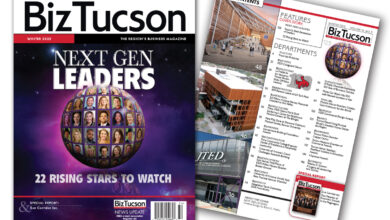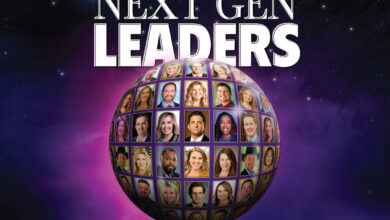
A Century of Rodeo
Tucson Rodeo Marks 100 Years
By Steve Rivera
It was about 55 years ago that Sam Merriman roamed the grounds of the Tucson Rodeo on the city’s south side doing his thing as a preteen, riding and roping cattle.
He has a long history with the Tucson Rodeo, which is celebrating 100 years of being part of the fabric of Tucson and its inclusive culture of Native Americans, Mexican Americans and the American cowboy.
“We are honored to present the centennial celebration of the Tucson Rodeo 2025,” said Merriman, this year’s Tucson Rodeo chair. “This iconic event is one of the longest consecutive running sports events in Southern Arizona. Our main goal is to provide a tradition of rodeo entertainment as well as giving a portion of its proceeds back to the community.”
The Tucson Rodeo has been a staple of the city’s lifestyle and culture for 100 years – impacting pretty much everyone who has ever lived in the city and its surroundings. After all, schools shut down during rodeo week – “rodeo vacation” as Merriman put it – and a big part of the city either goes to the popular rodeo parade or attends the rodeo.
Merriman remembers the crowds, the passion, the love for the sport back in the 1960s, when he was that preteen. How can he forget it? He lived it.
“It’s been a lifetime,” said Merimann, a former rodeo competitor turned NFL player turned rodeo authority. “This place is in my blood and always has been. It gets in your blood really fast – at least naturally for me it did.”
The same can be said for many that lived the life or were touched by it.
It has seemingly been that way since 1925 when Tucson’s La Fiesta de los Vaqueros was established, marking the city’s frontier spirit amidst the prohibition era, according to Tucson Rodeo’s website.
The rodeo was established to highlight Tucson’s Wild West spirit and attract tourists.
“The guest ranch business here in Tucson was one of the main industries where there were about 30-plus guest ranches in Tucson proper,” said Mark Baird, a former Tucson Rodeo chairman and current vice chairman. “The owners of those all got together and tried to figure out how to keep the visitors here for the winter longer. Why not try this?”
And so, the Tucson Rodeo was born.
Kids would cut class to go the rodeo, and their parents would either work at the rodeo or be in the rodeo, Baird said. By the 1930s, Baird said, school officials said, “why not have a holiday just because they kids were cutting class anyway.”
Thus, Tucson’s unique “rodeo vacation” came to fruition.
Ninety years later, Merriman estimates more than 3.5 million spectators have gone through the Tucson Rodeo turnstiles to see some the world’s best horsemen and women work their magic.
They went from prizes like a 750-pound block of ice and big cactus ham to more than $400,000 in prizes for this year’s event. More than $3 million in prize money has been handed out over the last 10 years.
Heck, even Hollywood has come through making its mark with movies like “8 Seconds” and “Ridin’ Wild” which were filmed at the Tucson Rodeo grounds.
But it was all the success from the early years, when locals and visitors came together, that made it a success that’s lasted 100 years.
“It evolved from something to occupy people to keep them in town to the event that it is today,” Baird said. “It’s grown into a major deal.”
Now, the Tucson Rodeo is the biggest outdoor winter rodeo and one of the best rodeos in North America, where the sports’ top athletes come to compete under ideal weather conditions in February. It’s ranked No. 4 as the biggest rodeo in the United States by the blog, usabynumbers.com.
Athletes like Trevor Brazile, Ty Murray, Joe Beaver, and the Wright family – Stetson, Rusty, Ryder and Cody – have all made their mark in Tucson.
“(Competitors) really have to be on their game to win this thing,” Baird said.
And it’s not just a competition in the arena, but the fun all around it, that makes it the event it is.
“We are in the entertainment business and all of that is the rodeo event,” Baird said. “In order to keep that entertainment aspect, we have to make sure we put on the best rodeo we can so they keep coming back. We want to make sure we keep it in the upper tier.”
Baird said Tucson from year to year has 20 to 30 of the top contestants who compete at the National Rodeo Finals in Las Vegas.
“It’s a pretty competitive atmosphere here,” he said. “We draw the best of the best.”
Still, they keep it light on the bells and whistles in part because at the end of the day, it’s a rodeo and it wants to remain that.
“There are a lot of things that other people do that we don’t do,” Baird said, “We are a rodeo and, yes, we have food vendors and things like that, but we are in the rodeo business. Yes, we do a concert every once and a while, and it’s nice to have it but we don’t have that for our sole draw. We rely on our performance, and it runs like clockwork. It’s a solid 2½ hours of entertainment.”
So, what’s been the secret to the rodeo’s success?
“We offer a good value for a family and a good source of entertainment that they can bring anybody from the age of two to 82 and everywhere in between,” Baird said. “Everybody will find something that they enjoy. It’s that atmosphere that we strive to maintain because that’s what keeps people coming back.”
What’s missing or who is missing from this big celebration is the late Gary Williams, long a staple of the rodeo since the 1980s. He, seemingly, was Mr. Tucson Rodeo, given his knowledge of the event.
“It was like working with an encyclopedia,” Baird said. “We won’t find anybody who was dedicated as much to rodeo or our event. This event was his passion. He is missed dearly daily.”





